
Ever notice how some people meticulously plan every detail of their summer travel while others thrive on spontaneous adventures? Our behaviors, shaped by backgrounds, habits, and emotions, orchestrate the rhythm of our lives. You can be a planner who organizes every detail of your travel and feel joy. Or, you can be someone who craves the thrill of the unknown.
As marketers, understanding and categorizing these diverse approaches is where behavioral segmentation takes center stage.
It’s not merely acknowledging these distinct habits but crafting marketing campaigns that sync seamlessly with these behavioral rhythms. In this article, we’ll dive into the basics of behavioral segmentation. Join us on this exploration as we tell you how marketers can use these behavioral patterns to fine-tune their campaigns and align with the diverse ways customers approach life and decision-making.
Behavioral Segmentation
What is Behavioral Segmentation?
Behavioral segmentation is a marketing strategy that categorizes customers based on their behaviors, attitudes, and usage patterns. In this approach, customers are grouped based on how they interact with a product or service, their purchasing habits, brand loyalty, and other behavioral factors.
This approach to segmentation acknowledges that consumers with similar behaviors may respond similarly to marketing efforts. Therefore, businesses can tailor their marketing strategies and offerings to specific segments, addressing each group’s unique needs and preferences.
Why Behavioral Segmentation is Important?
Leveraging behavioral segmentation in your marketing strategy is crucial because it empowers businesses to understand and respond to their customers’ diverse behaviors, preferences, and needs. After identifying customers through their specific behaviors, attitudes, and usage patterns, marketers can tailor specific segments by adjusting their marketing strategies, messages, and offerings.
This approach enhances the effectiveness of marketing efforts, increases customer satisfaction, and ultimately contributes to the business’s overall success. By delivering more personalized and relevant experiences, businesses can foster stronger customer relationships and optimize resource allocation for maximum impact.
Benefits of Utilizing Behavioral Segmentation
Behavioral segmentation plays a crucial role in marketing strategy, as it enables businesses to understand and target their customers by considering their distinctive behaviors, actions, and patterns. Here are the benefits of using behavioral segmentation as a marketing strategy:
1. Personalization
By learning what your customers like and don’t like, you can create more personalized and engaging experiences to enhance customer satisfaction and loyalty. Moreover, it helps you understand which channels your customers prefer and what type of message they respond to the most.
2. Improved Product Development
Understanding how customers behave can help businesses gain insights into how customers use their products and services. Therefore, businesses can improve product innovation, development, customization, and enhancement to ensure their offerings align with customer needs and wants.
3. Resource Allocation
By knowing the segments that spend the most, businesses can allocate resources more efficiently by focusing on high-value customer segments and maximizing the impact of their marketing efforts.
4. Customer Insights
Behavioral segmentation provides valuable insights into customer motivations, which enables businesses to make informed decisions, stay ahead of market trends, and effectively plan for the future.
5. Competitive Advantage
Understanding and responding to customer behaviors gives businesses a competitive advantage by staying relevant and meeting customer expectations.
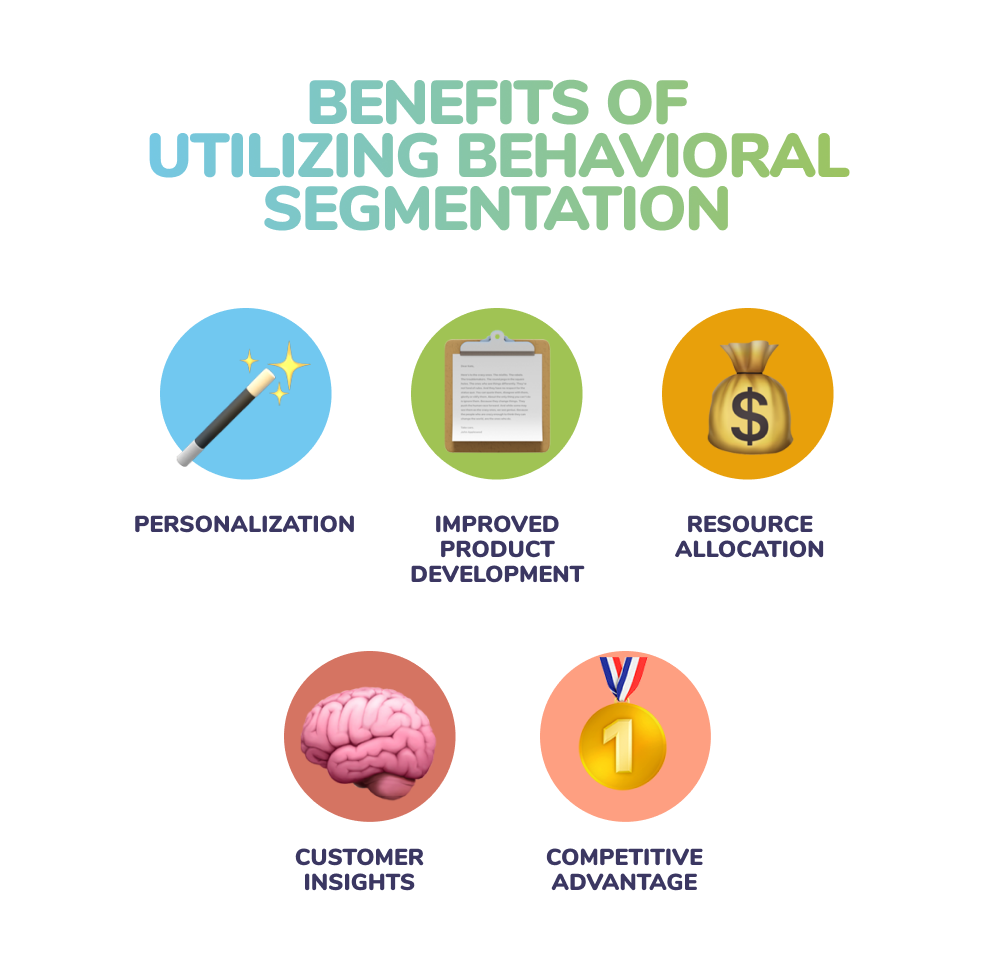
Types of Behavioral Segmentation
Behavioral segmentation can come in various forms. Here are a few types:
1. Occasion-Based Segmentation
It divides customers based on their behaviors during specific occasions or events. When individuals purchase a product for a particular occasion, they may repeat it or never engage in it again. Distinct behaviors and purchasing patterns often manifest in people, whether it’s during holidays, birthdays, or seasonal events.
Understanding how people act based on the occasion can help companies tailor their marketing efforts to resonate with the unique needs and motivations that arise during different events.
2. Usage-Based Segmentation
It involves categorizing customers based on product or service usage patterns. This strategy focuses on understanding how many times the consumer uses a product. It goes beyond identifying who buys a product and delves into the frequency, intensity, and purpose of their usage. Grouping customers based on their product usage is possible by assessing how often and how much they use the product. Usage levels can range from heavy and moderate to minor.
By employing usage-oriented behavioral segmentation, businesses can tailor their marketing strategies to meet each usage segment’s needs and expectations. This type of segmentation allows for more personalized and targeted approaches, ensuring that marketing messages and product enhancements resonate with the diverse usage patterns within the customer base.
3. Loyalty-Based Segmentation
It focuses on categorizing customers according to their level of loyalty to a brand or product. This strategy recognizes that customers exhibit varying loyalty, from occasional buyers to brand enthusiasts. It helps businesses find customers who are loyal to the brand and are more likely to tell others about it.
Businesses can tailor their strategies to nurture and maintain customer loyalty by understanding and grouping customers based on their loyalty behaviors.
Loyalty-based segmentation can identify different segments, such as:
1. Brand Advocates: Customers who consistently choose and actively recommend a particular brand to others.
2. Regular Buyers: Customers who frequently make purchases from a brand but may not actively promote it.
3. Occasional Shoppers: Customers who make sporadic purchases and are less committed to a specific brand.
4. Switchers: Customers who switch between brands based on promotions or external factors.
By recognizing and addressing each loyalty segment’s distinct needs and motivations, businesses can implement targeted retention strategies, loyalty programs, and communication approaches to strengthen and deepen customer relationships.
4. Benefit-Based Segmentation
It takes behavioral segmentation a step further by focusing on the perceived benefits that customers seek from a product or service. There are different benefits that customers look for when purchasing a product, such as availability, price, ease of use, quality, performance, or other varieties that will meet their needs.
For example, for a fitness app, you might have segments based on different benefits users are seeking. Some might use the app primarily for weight loss, while others focus on building muscle or improving flexibility. Understanding these distinct benefits allows you to tailor your messaging and features to meet each segment’s specific needs and motivations.
Benefit-based segmentation allows you to align your product offerings with your customers’ specific goals and desires, creating a more personalized and effective marketing strategy.
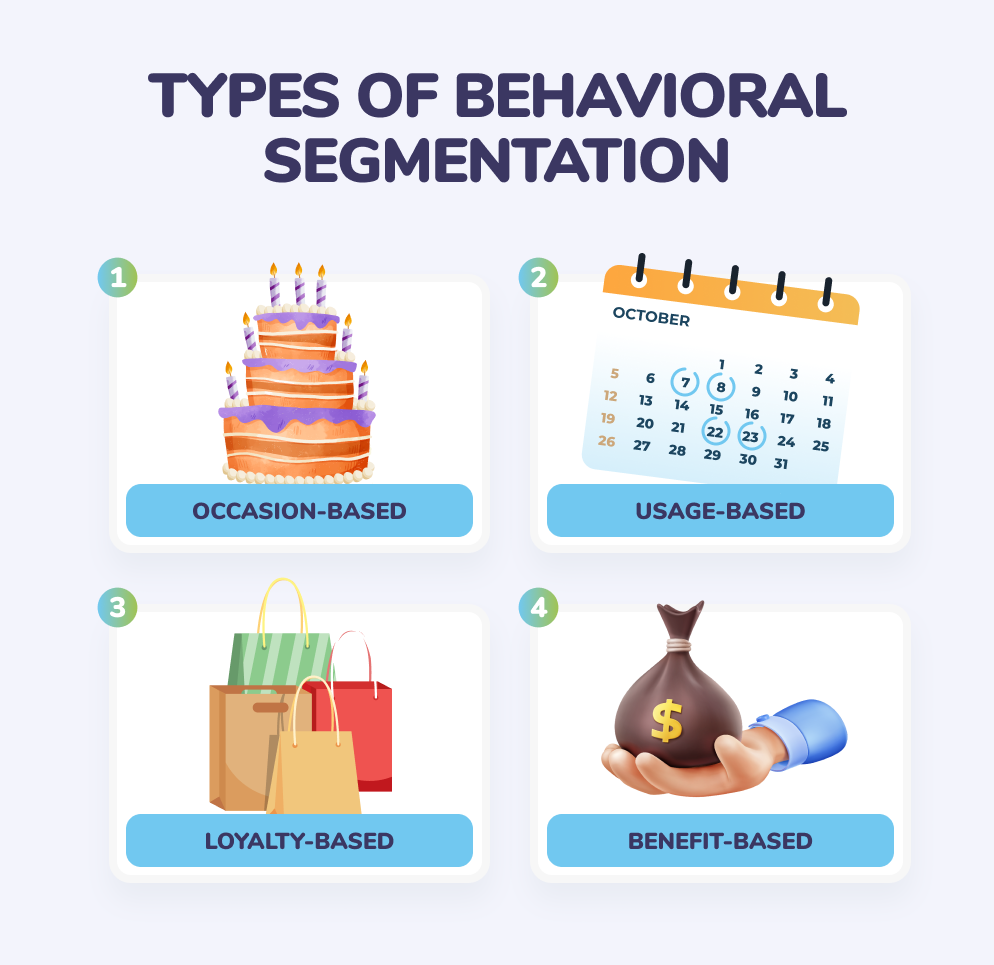
Examples of Behavioral Segmentation
These examples showcase how behavioral segmentation can be applied across various industries to create more targeted and effective marketing strategies.
1. Purchase Behavior
Segmenting customers based on purchasing patterns helps companies tailor marketing campaigns or loyalty programs to enhance customer satisfaction and retention. To illustrate, let’s think about an OTT brand.
To tailor marketing campaigns based on purchase patterns, we can group our customers as “TV Series Enthusiasts,” “Movie Gurus,” “Documentary Lovers,” and “Casual Viewers”.
For TV series enthuistasts, we can focus on promoting trending TV series, creating watchlists, and even releasing entire seasons at once for a binge-worthy experience. Personalized recommendations for similar series can also enhance their user experience.
On the other hand, for movie gurus, we can highlight new movie releases, offer curated playlists, and provide personalized recommendations based on their movie-watching history.
For documentary lovers, we can create curated sections for documentaries, offer educational series, and provide in-depth content recommendations based on their interests. Additionally, they might appreciate behind-the-scenes footage or exclusive interviews with documentary creators.
Lastly, for casual viewers, a user-friendly interface, personalized recommendations across various genres, and occasional promotions or discounts might encourage continued subscriptions.
Why did we implement this strategy? The casual viewers segment includes subscribers who use the OTT platform casually, without a strong preference for specific genres or types of content. We can simultaneously increase engagement and learn more about their preferences by offering personalized recommendations across various genres to this segment.
Group customers according to purchasing patterns to change segments into different industries or brands. For instance, in e-commerce, some customers might be frequent buyers, while others only purchase during sales or promotions.

2. Usage Frequency
Categorizing customers based on how often they use a product or service allows companies to target promotions or feature updates to each group’s usage patterns. For example, a music streaming service might have segments like daily users, occasional listeners, working music seekers, or weekend binge-listeners.
For users who engage with the music streaming platform daily, we could offer personalized daily playlists, mood suggestions, and notifications for new releases from their favorite artists.
Secondly, for occasional listeners who use the platform occasionally and do not have a fixed routine for music consumption, we can send personalized recommendations based on their usage patterns, offer occasional promotions, and use targeted advertising to highlight new features or content.
For working music seekers who use the platform while working or studying, we can suggest focus-enhancing and low-tempo playlists, provide a “work mode” feature that filters out distracting content, and offer occasional breaks with personalized music suggestions.
Lastly, for weekend binge-listeners who use the platform intensively on weekends while focusing on high-tempo party music, we can curate special weekend playlists and suggest party or relaxation playlists based on their weekend usage and patterns.
By segmenting users based on their usage frequency and tailoring the platform’s features, recommendations, and promotions to each group’s habits, the music streaming platform can create a more personalized and engaging experience for its diverse user base.
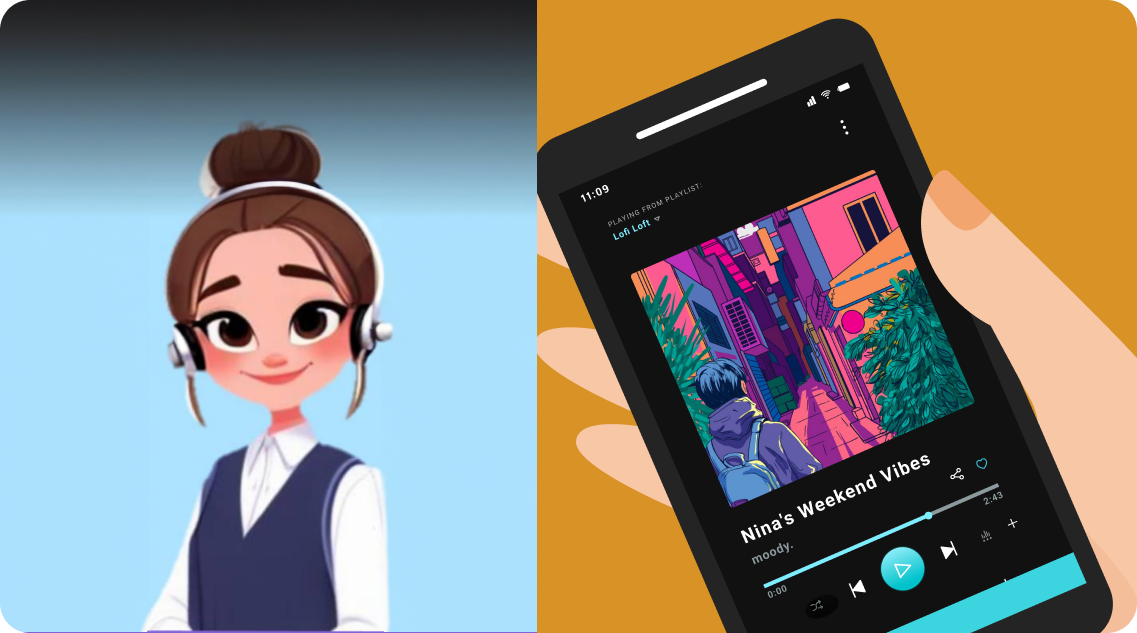
3. Product Loyalty
Identifying segments based on brand or product loyalty can help companies craft targeted loyalty programs or incentives. For example, some customers might consistently choose one brand over others, while others may switch. To illustrate, we can think of a skincare brand.
For brand enthusiasts who are incredibly loyal to our brand and who consistently purchase our products, engage with our social media accounts, and actively participate in loyalty programs, we can offer exclusive early access to new product releases, personalized discounts, invitations to special events, or focus groups.
Moreover, we can encourage loyalty for occasional buyers who purchase from our brand occasionally but not exclusively. To do so, offering targeted promotions, personalized product recommendations based on purchase history, or inviting them to participate in surveys to understand their preferences better might help us tailor marketing campaigns accordingly.
For trial users who have tried a few products from our brand but haven’t fully committed, we need to try to find ways to convert them into loyal customers. For example, we can provide sample-sized products with purchases to highlight our other products, offer trial kits for new customers, and send personalized follow-up emails with tips about skincare routines or suggestions.
On the other hand, we need to maintain loyalty for discount lovers, who may be loyal to our brand when it is time for a sale event and promotions. To do so, we can create a loyalty program with increasing benefits based on purchase frequency, offer exclusive discounts, and highlight the loyalty program’s value beyond discounts.
Lastly, for inactive loyalists who were once loyal to our brand but have become less engaged over time, we must find a way to re-ignite their loyalty. To do this, we can send personalized re-engagement emails, offer exclusive comeback promotions, and provide sneak peeks of upcoming products to recover the interest.
By understanding and catering to these segments based on their level of product loyalty, the skincare brand can develop targeted strategies to strengthen customer relationships, increase customer retention, and foster a sense of brand loyalty among its diverse customer base.
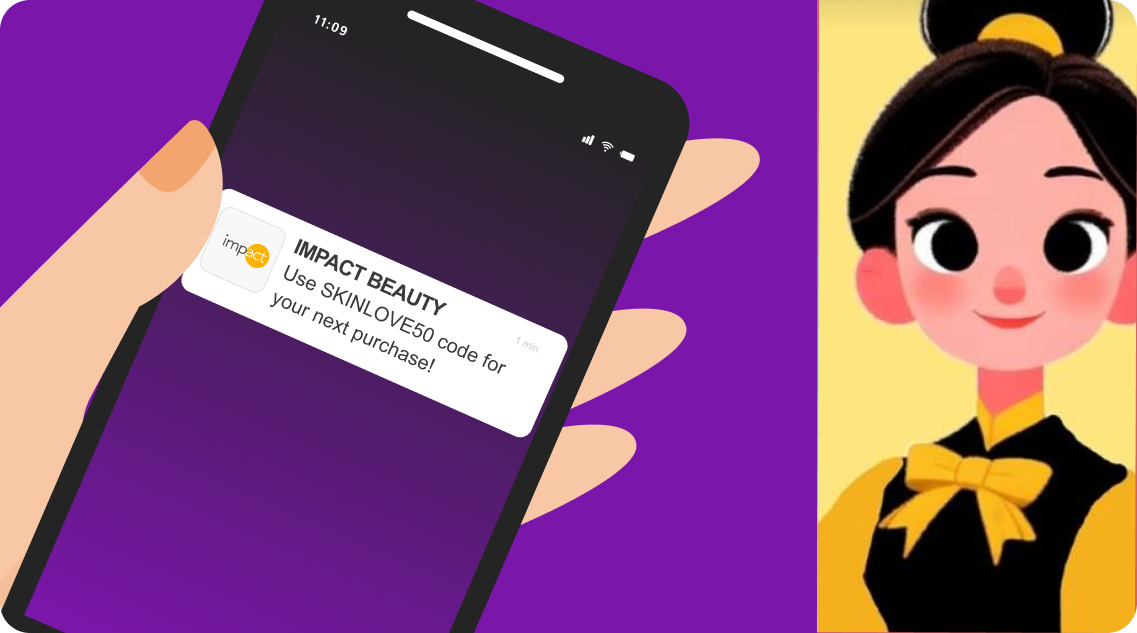
4. Response to The Marketing Channel
Segmenting based on how customers respond to a marketing channel helps companies optimize their marketing channels for better reach and effectiveness. For example, think about a tech company that sells tech products and gadgets.
For social media lovers who are highly active on social media platforms and engage with our brand through likes, shares, and comments on posts, we can focus on visually appealing content, social media contests, and influencer marketing to create buzz around new product launches.
Furthermore, for email enthusiasts who prefer communication through email, open newsletters, click on product announcements and participate in exclusive email promotions, we can send personalized product recommendations, discounts, and early access to limited-edition products.
For in-store shoppers who prefer traditional in-store experiences, we can enhance their experience by organizing hands-on product demos, offering exclusive in-store promotions and events, and creating a seamless transition between online and in-store shopping with QR codes for more information.
Moreover, for tech geeks and online readers who stay informed through tech blogs and review sites, we can collaborate with tech influencers for reviews, provide detailed product specifications on our website, and share positive reviews and testimonials occasionally.
By understanding and catering to these segments based on their preferred marketing channels, the tech gadget brand can optimize its marketing strategies, ensuring that messages reach the right audience through the most effective channels for each segment.
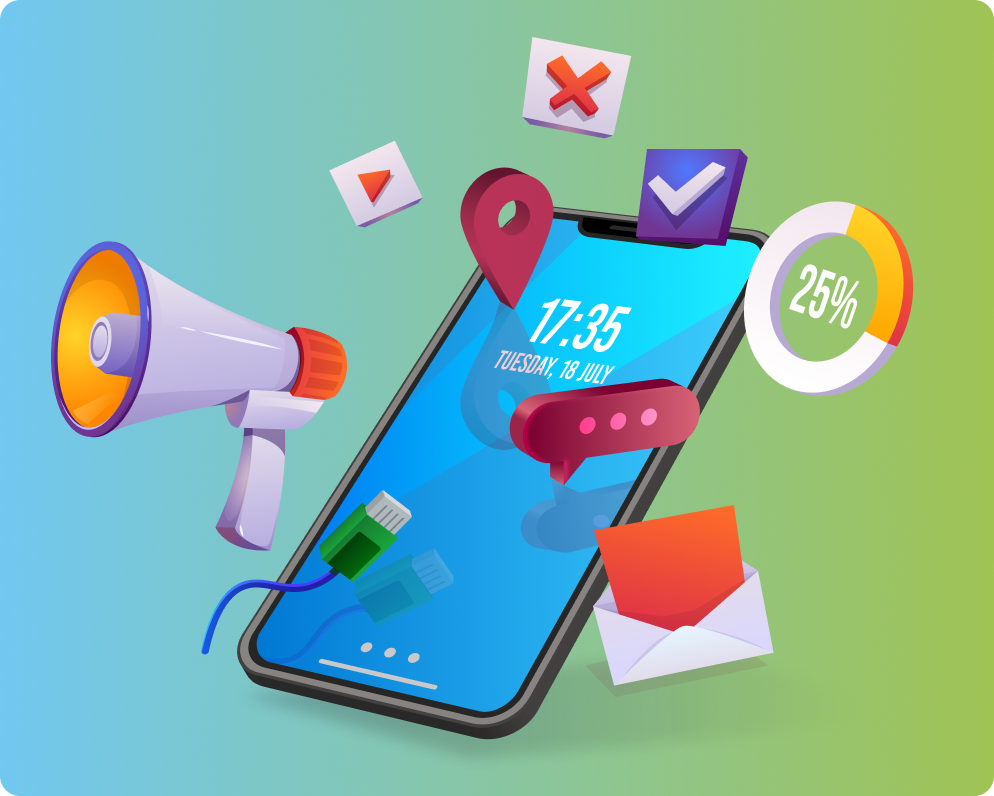
5. Online Behavior
Analyzing how users behave online may help marketers tailor the online experience and marketing strategies to each segment’s preferences. Analyzing users according to their online behaviors could include segments such as frequent website visitors, mobile app users, or customers who engage with the brand through social media. To illustrate, let’s think about a travel booking platform.
For website visitors who regularly visit our website, we can enhance their experience by offering personalized homepage recommendations, quick-access buttons to their most-searched destinations, and upselling with our other brand collaborations, such as car rentals or flight recommendations.
On the other hand, for mobile app users who prefer using the mobile app, we can optimize the app experience by sending push notifications for personalized travel deals and integrating user-friendly features like one-click bookings or early access to flash sales.
Moreover, for social media engagers who actively engage with our platforms on social media, we can run social media contests, share user-generated travel stories, provide exclusive promo codes, and create a sense of community to encourage users to share their travel experiences.
For cart abandoners who frequently add trips to their cart but don’t complete the booking, we can implement targeted email campaigns with personalized offers, reminder notifications, and incentives such as loyalty points for completing the booking to reduce cart abandonment rates.
Lastly, for review watchers, who often rely on online reviews before making travel decisions, we can showcase user testimonials, encourage customers to leave reviews, and offer discounts for users who share their travel experiences on the platform.
By understanding and catering to these segments based on their online behavior, the travel booking platform can optimize its online interface, marketing strategies, and engagement tactics to provide a more personalized and satisfying experience for its diverse user base.
6. Abandonment Behavior
By understanding the behavior of users who abandon a shopping cart or exit a website without making a purchase, businesses can identify reasons for abandonment and implement strategies to reduce cart abandonment rates, such as targeted follow-up emails or special offers. For example, let’s think about an e-commerce fashion brand.
For frequent cart abandoners, who often add items to their shopping cart but leave without completing the purchase, we can implement an automated email campaign strategy targeting this segment. We can lower abandonment rates by featuring personalized product recommendations, limited-time offers, or reminders to complete their purchases.
Secondly, for browsers who browse products without adding them to the cart, we can personalize homepage recommendations and give exclusive sneak peeks or early access to upcoming collections. We can also provide incentives like free shipping to encourage them to purchase.
Moreover, for code chasers who frequently abandon their carts to search for coupon codes, we can implement a pop-up or exit-intent offer with a dynamic coupon code to incentivize immediate purchases. This strategy could reduce the likelihood of users leaving to find discounted products elsewhere.
For concerned shoppers who abandon their carts due to uncertainty about size or fit, we can provide detailed size guides and send targeted notifications with customer reviews emphasizing the fit and sizing of products.
Lastly, for shipping cost haters who abandon carts because of high shipping costs, we can provide free shipping promotions, threshold-based discounts, or limited-time offers to reduce or eliminate shipping charges. These strategies can encourage customers to complete their purchases.
By understanding and addressing these abandonment behaviors, the e-commerce fashion brand can tailor its strategies to re-engage users, reduce cart abandonment rates, and create a more seamless and satisfying shopping experience.

Conclusion
Recognizing and adapting to your audience’s behavioral patterns is the key to effective marketing. By delving into these patterns, marketers can tailor their messages to resonate with specific audiences, ultimately steering their campaigns toward success.
So, as you embark on your marketing journey, remember: it’s not just about what you offer but how well you understand the unique behaviors that shape your audience. Cheers to decoding the secrets of consumer behavior and elevating your marketing strategy!
